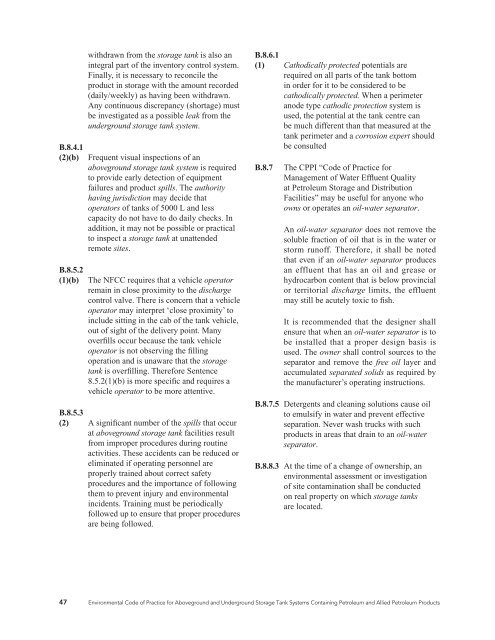Environmental Code of Practice for Aboveground and ... - CCME
Environmental Code of Practice for Aboveground and ... - CCME
Environmental Code of Practice for Aboveground and ... - CCME
You also want an ePaper? Increase the reach of your titles
YUMPU automatically turns print PDFs into web optimized ePapers that Google loves.
withdrawn from the storage tank is also an<br />
integral part <strong>of</strong> the inventory control system.<br />
Finally, it is necessary to reconcile the<br />
product in storage with the amount recorded<br />
(daily/weekly) as having been withdrawn.<br />
Any continuous discrepancy (shortage) must<br />
be investigated as a possible leak from the<br />
underground storage tank system.<br />
B.8.4.1<br />
(2)(b) Frequent visual inspections <strong>of</strong> an<br />
aboveground storage tank system is required<br />
to provide early detection <strong>of</strong> equipment<br />
failures <strong>and</strong> product spills. The authority<br />
having jurisdiction may decide that<br />
operators <strong>of</strong> tanks <strong>of</strong> 5000 L <strong>and</strong> less<br />
capacity do not have to do daily checks. In<br />
addition, it may not be possible or practical<br />
to inspect a storage tank at unattended<br />
remote sites.<br />
B.8.5.2<br />
(1)(b) The NFCC requires that a vehicle operator<br />
remain in close proximity to the discharge<br />
control valve. There is concern that a vehicle<br />
operator may interpret ‘close proximity’ to<br />
include sitting in the cab <strong>of</strong> the tank vehicle,<br />
out <strong>of</strong> sight <strong>of</strong> the delivery point. Many<br />
overfills occur because the tank vehicle<br />
operator is not observing the filling<br />
operation <strong>and</strong> is unaware that the storage<br />
tank is overfilling. There<strong>for</strong>e Sentence<br />
8.5.2(1)(b) is more specific <strong>and</strong> requires a<br />
vehicle operator to be more attentive.<br />
B.8.5.3<br />
(2) A significant number <strong>of</strong> the spills that occur<br />
at aboveground storage tank facilities result<br />
from improper procedures during routine<br />
activities. These accidents can be reduced or<br />
eliminated if operating personnel are<br />
properly trained about correct safety<br />
procedures <strong>and</strong> the importance <strong>of</strong> following<br />
them to prevent injury <strong>and</strong> environmental<br />
incidents. Training must be periodically<br />
followed up to ensure that proper procedures<br />
are being followed.<br />
B.8.6.1<br />
(1) Cathodically protected potentials are<br />
required on all parts <strong>of</strong> the tank bottom<br />
in order <strong>for</strong> it to be considered to be<br />
cathodically protected. When a perimeter<br />
anode type cathodic protection system is<br />
used, the potential at the tank centre can<br />
be much different than that measured at the<br />
tank perimeter <strong>and</strong> a corrosion expert should<br />
be consulted<br />
B.8.7 The CPPI “<strong>Code</strong> <strong>of</strong> <strong>Practice</strong> <strong>for</strong><br />
Management <strong>of</strong> Water Effluent Quality<br />
at Petroleum Storage <strong>and</strong> Distribution<br />
Facilities” may be useful <strong>for</strong> anyone who<br />
owns or operates an oil-water separator.<br />
An oil-water separator does not remove the<br />
soluble fraction <strong>of</strong> oil that is in the water or<br />
storm run<strong>of</strong>f. There<strong>for</strong>e, it shall be noted<br />
that even if an oil-water separator produces<br />
an effluent that has an oil <strong>and</strong> grease or<br />
hydrocarbon content that is below provincial<br />
or territorial discharge limits, the effluent<br />
may still be acutely toxic to fish.<br />
It is recommended that the designer shall<br />
ensure that when an oil-water separator is to<br />
be installed that a proper design basis is<br />
used. The owner shall control sources to the<br />
separator <strong>and</strong> remove the free oil layer <strong>and</strong><br />
accumulated separated solids as required by<br />
the manufacturer’s operating instructions.<br />
B.8.7.5 Detergents <strong>and</strong> cleaning solutions cause oil<br />
to emulsify in water <strong>and</strong> prevent effective<br />
separation. Never wash trucks with such<br />
products in areas that drain to an oil-water<br />
separator.<br />
B.8.8.3 At the time <strong>of</strong> a change <strong>of</strong> ownership, an<br />
environmental assessment or investigation<br />
<strong>of</strong> site contamination shall be conducted<br />
on real property on which storage tanks<br />
are located.<br />
47 <strong>Environmental</strong> <strong>Code</strong> <strong>of</strong> <strong>Practice</strong> <strong>for</strong> <strong>Aboveground</strong> <strong>and</strong> Underground Storage Tank Systems Containing Petroleum <strong>and</strong> Allied Petroleum Products

















